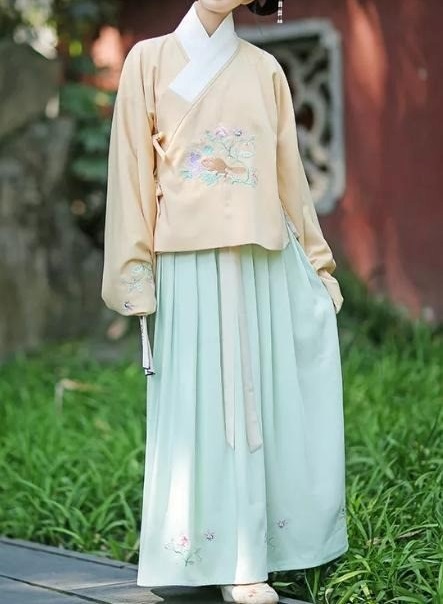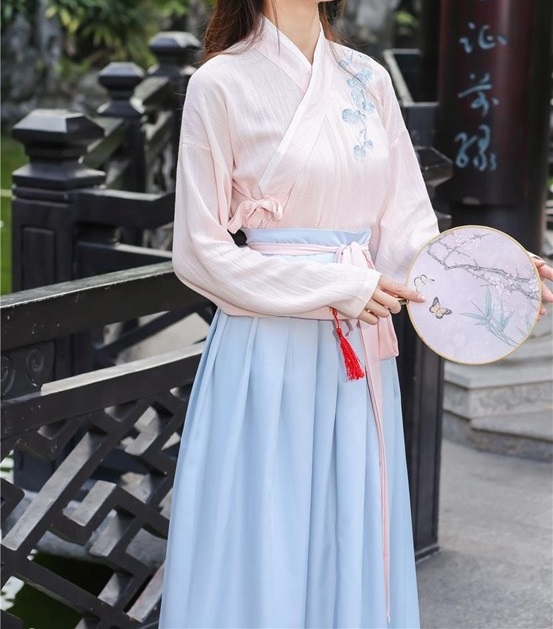Our main products: Amino silicone, block silicone, hydrophilic silicone,all of their silicone emulsion,wetting rubbing fastness improver, water repellent(Fluorine free,Carbon 6,Carbon 8), demin washing chemicals(ABS, Enzyme, Spandex protector, Manganese remover), Main export countries: India, Pakistan, Bangladesh, Türkiye, Indonesia, Uzbekistan, etc.,more detail please contact : Mandy +86 19856618619 (Whatsapp )
Silicone Softeners: The Modern Innovation of Traditional Hanfu
Hanfu, the iconic symbol of traditional Chinese clothing, carries a rich cultural heritage spanning thousands of years. Its unique tailoring techniques, intricate and exquisite patterns, and carefully selected fabrics showcase the profound beauty of Eastern aesthetics. In the contemporary era, with the continuous advancement of textile technology, silicone softeners have emerged as a crucial factor driving the evolution and inheritance of Hanfu. They have revolutionized the production process of Hanfu and greatly enhanced the wearing experience.
The Innovation of Hanfu Fabrics: Unveiling the Value of Silicone Softeners
Traditional Hanfu mainly uses natural materials such as silk, cotton, and linen. Although these fabrics possess unique charm and quality, they often suffer from issues such as stiffness and a tendency to wrinkle. The advent of silicone softeners has provided a much - needed solution to improve the performance of these classic fabrics. When applied to silk, silicone softeners can significantly enhance the smoothness and drape of silk, allowing the fabric to gracefully conform to the curves of the human body and further highlighting the wearer's elegance. For cotton and linen, these softeners can effectively reduce their inherent roughness and enhance the comfort during wearing. Through the fine optimization of the application process, silicone softeners can enhance the fabric's performance while preserving the original charm and texture of Hanfu, achieving a harmonious integration of tradition and modernity.
Technological Breakthroughs: The Application of Silicone Softeners in Hanfu Production
During the production of Hanfu, silicone softeners can be incorporated through various methods such as impregnation and spraying. Manufacturers customize the treatment process according to the characteristics of different fabrics to ensure the best results without affecting the breathability of the fabric. Hanfu fabrics treated with silicone not only have a luxurious and soft touch but also exhibit excellent wrinkle resistance and dimensional stability. These improvements in performance make Hanfu more suitable for daily wearing and maintenance, thus promoting the wider dissemination of traditional Chinese culture. Practical applications have shown that Hanfu treated with silicone softeners, while successfully retaining its traditional essence, has significantly improved comfort and practicality, winning the love of many Hanfu enthusiasts.

Cultural Inheritance: How Silicone Softeners Promote the Modernization of Hanfu
The use of silicone softeners has effectively shattered the long - standing perception that Hanfu is merely a decorative garment lacking practicality. The treated fabrics are easier to care for, lowering the threshold for wearing Hanfu in daily life. In the field of Hanfu design innovation, silicone softeners have opened up new creative spaces for designers. The improvement in fabric performance enables the seamless integration of traditional elements with modern design concepts, injecting new vitality into this ancient form of clothing. With the continuous progress of treatment technologies, silicone softeners will undoubtedly play an even more crucial role in the inheritance and evolution of Hanfu culture, allowing this traditional cultural symbol to radiate new vitality in modern society. The application of silicone softeners in the field of Hanfu reflects the perfect integration of tradition and modern technology. This innovation not only enhances the practicality of Hanfu but also opens up new avenues for the protection of cultural heritage. In the future, with further technological development and wider application, silicone softeners will surely inject new impetus into the development of Hanfu culture, enabling this ancient art form to shine more brightly in the modern world.
The application of silicone softeners in the production of Hanfu is mainly reflected in the following aspects:
Application Methods -
Immersion Method:
Immerse the Hanfu fabric in a solution containing silicone softener, enabling the softener to fully penetrate into the fabric fibers. This method allows the softener to come into full contact with and bond to the fibers, distributing evenly within the fabric, thus comprehensively enhancing properties such as the softness and smoothness of the fabric. Generally, parameters such as the immersion time, solution concentration, and temperature are adjusted according to the fabric's material, thickness, and the desired softening effect. For example, for silk fabrics, a silicone softener solution with a relatively low concentration may be used, and the fabric is immersed at a relatively mild temperature for an appropriate period to achieve the effect of improving softness without damaging the silk fibers.

Spraying Method:
Use equipment such as spray guns to evenly spray the silicone softener onto the surface of the Hanfu fabric. This method is suitable for some fabrics that are not suitable for long - term immersion or require local treatment. According to design requirements, the softener can be sprayed onto specific parts of the Hanfu, such as the collar and cuffs, which come into easy contact with the skin, to enhance wearing comfort. At the same time, the spraying method can control the amount and distribution range of the softener, which is better for preserving the original characteristics and design effects of fabrics with special patterns or materials.

Process Customization - Based on Different Fabric Characteristics:
Silk Fabrics:
Silk is inherently soft, but it may lack smoothness and good drape. When applying silicone softeners, those with a relatively small molecular structure and good permeability are selected to better penetrate into the silk fibers, enhance the lubricity between the fibers, improve the smoothness and drape of the silk, and enable it to gracefully conform to the curves of the human body.
Cotton Fabrics:
Cotton fabrics are usually skin - friendly, but they may feel rough. For cotton fabrics, silicone softeners with good hydrophilicity and softness are chosen. These softeners can form a soft protective film on the surface of cotton fibers, effectively reducing the roughness. At the same time, they improve the fabric's wrinkle resistance, making the Hanfu more comfortable to wear and less prone to wrinkling.
Linen Fabrics:
Linen fibers are relatively tough and the handfeel is relatively stiff. For linen fabrics, silicone softeners that can increase fiber flexibility are used. By combining with the linen fibers, the rigidity of the fibers is reduced, making them softer. At the same time, the original breathability and hygroscopicity of the linen fabric are maintained, so that the Hanfu not only has the unique texture of linen but also provides a good wearing experience.
Ensuring Breathability:
In the production of Hanfu, regardless of the fabric used, it is necessary to ensure that the breathability of the fabric is not affected. A large number of tests and optimizations are carried out when selecting silicone softeners and determining the application process. For example, control the amount of softener to avoid excessive softener blocking the pores of the fabric; select softener varieties with good breathability. The protective film formed by these softeners on the fiber surface can not only provide a softening effect but also ensure the normal circulation of air and water vapor, so that the wearer will not feel stuffy when wearing Hanfu and can stay comfortable and dry.
Post - treatment Procedures - Drying Treatment:
After applying the silicone softener to the Hanfu fabric, drying treatment is required. The drying temperature and time also have a certain impact on the softening effect. Generally, appropriate drying conditions are selected according to the fabric's material and the characteristics of the softener. For some sensitive fabrics, such as silk, a low - temperature and slow - drying method is adopted to avoid fabric deformation or impairment of the softener's performance caused by high temperatures.
Finishing and Shaping:
After drying, the fabric may be uneven and requires finishing and shaping. At this time, methods such as ironing can be used. Under appropriate temperature and pressure, the fabric is made smoother, and at the same time, the distribution of the silicone softener in the fibers becomes more uniform, further enhancing the softening effect and the overall texture of the fabric, ensuring that the Hanfu has a smooth and beautiful appearance and is comfortable to wear.
Post time: Feb-19-2025

